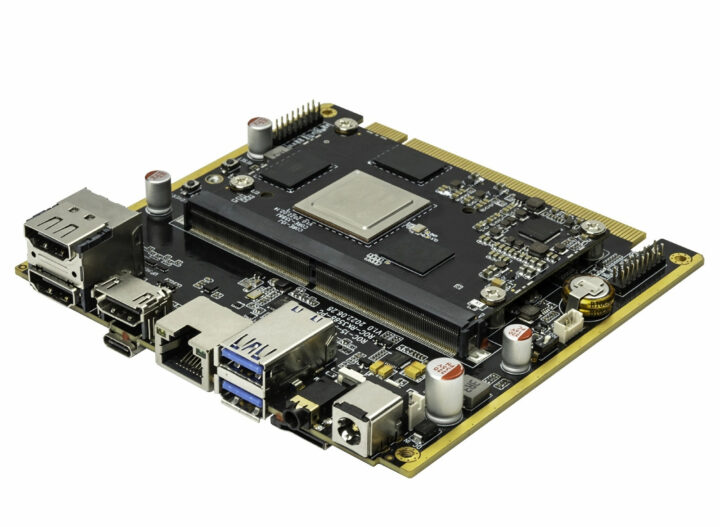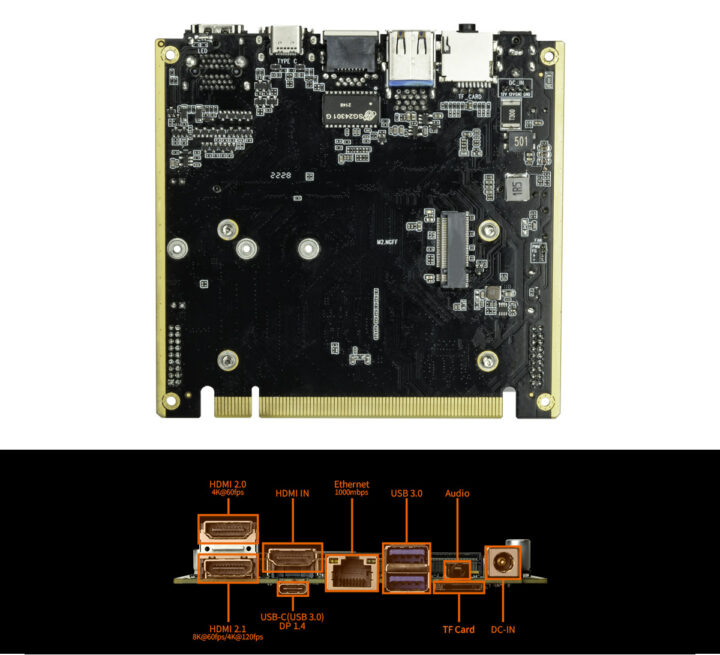The Rockchip RK3588 datasheet clearly states the processor supports up to 32 GB RAM, and many vendors claimed their board supports up to 32GB RAM at launch, but none were to be found once you accessed a shop, and the maximum was 16GB RAM so far, likely due to availability and the high price of of the two 16GB RAM chips needed to get 32GB of RAM.
But Firefly has now discreetly started to sell boards with 32GB RAM including the ROC-RK3588-PC, ROC-RK3588S-PC, and ITX-3358J mini-ITX motherboard. I’ve just noticed I never covered the former, so I’ll have a closer look at it today.
Firefly ROC-RK3588S-PC specifications:
- SoM – Core-3588J system-on-module
- SoC – Rockchip RK3588 octa-core processor with 4x Cortex-A76 cores @ up to 2.4 GHz, four Cortex-A55 cores, Arm Mali-G610 MP4 quad-core GPU with OpenGL ES3.2 / OpenCL 2.2 / Vulkan 1.1 support, 6 TOPS NPU, and an 8Kp60 H.265/VP9/AVS2 video decoder, 4Kp60 decoder, 8Kp30 H.265/H.264 video encoder
- System Memory – 4GB, 8GB, 16GB, or 32GB LPDDR4/LPDDR4x/LPDDR5
- Storage – 16GB, 32GB, 64GB, 128GB, or 256GB eMMC flash
- PMIC – Rockchip RK806-1
- Carrier board interface – 314-pin MXM 3.0 edge connector
- Dimensions – 82 mm × 53 mm
- Carrier board
- Storage
- M.2 (PCIe 3.0) socket for M.2 2242/2260/2280 NVMe SSD
- MicroSD card slot
- Video Output
- HDMI 2.1 port up to 8Kp60
- HDMI 2.0 port up to 4Kp60
- DisplayPort 1.4 up to 8Kp30 via USB-C port
- Up to two independent video outputs
- Video Input – HDMI input
- Audio
- 3.5mm audio (headphone+mic) jack
- Digital audio output via HDMI and DP ports
- Line OUT on header
- Networking
- Low-profile Gigabit Ethernet RJ45 port
- Dual-band WiFi 6 (802.11ax) and Bluetooth 5.0
- USB – 2x USB 3.0 Type-A ports, 1x USB Type-C port with DP Alt mode
- Expansion
- M.2 (PCIe 3.0) socket for NVMe SSD
- 164-pin “PCIe 16x” edge connector with
- Display – MIPI DSI, VGA, DP 1.4
- Camera – MIPI CSI
- Audio – S/PDIF
- Networking – Gigabit Ethernet, 5G/4G LTE interface
- USB – USB 3.0
- Serial – CAN Bus
- PCIe – PCIe 2.0
- Low-speed I/Os – I2C, UART, PWM
- Headers with UART, ADC, CAN Bus, Debug, SPI, I2C, and Line Out
- Power Supply – 12V DC input via 5.5×2.1mm DC jack
- Dimensions – 118 x 111.6 mm
- Storage
- Power Consumption
- Idle: 1.2W (12V/100mA)
- Typical: 8.04W (12V/670mA)
- Max: 14.4W (12V/1,200mA)
- Weight – Around 150 grams
- Temperature Range – Operating: -20°C to 60°C; storage: -20°C to 70°C
- Humidity – 10% to 80% (storage)
The company provides Android 12, Debian, and Ubuntu images, Android and Linux SDKs, an HDMI input demo, tools, and some documentation on the download page. But you’ll find more resources to get started and instructions to use the various interfaces in the Wiki.
So how much does a Rockchip RK3588 SBC with 32GB RAM (and 256GB eMMC flash) cost exactly? At the time of writing…
- The ROC-RK3588S-PC can be purchased for $469 on the Firefly store.
- The ROC-RK3588-PC is available for $549 on Aliexpress or $615 on the Firefly store.
- The full-featured ITX-3388J mini-ITX goes for $829 on the company’s store.
I’m assuming other companies will follow suit soon, and offer some of their boards with 32GB RAM as well.
Thanks to Calvin for the tip.

Jean-Luc started CNX Software in 2010 as a part-time endeavor, before quitting his job as a software engineering manager, and starting to write daily news, and reviews full time later in 2011.
Support CNX Software! Donate via cryptocurrencies, become a Patron on Patreon, or purchase goods on Amazon or Aliexpress. We also use affiliate links in articles to earn commissions if you make a purchase after clicking on those links.







It looks like Mouser and Digikey now list a lot of Micron 128Gbit LPDDR4/LPDDR5 chips, but none of them are actually in stock, and they are four times the cost of a DDR4 DIMM of the same capacity.
While it’s nice to finally see these configurations become available, it may have a hard time competing with x86 machines when they give you better performance and more RAM for less money.
What is the current mainlining progress of the rk3588? Is it possible to run a full wayland desktop with 100% opensourcr software and active gpu acceleration like its possible with the odroid n2?
Mainline is not usable with graphics, and PCIe has not been implemented yet. See comment @ https://www.cnx-software.com/2023/06/26/linux-6-4-release-main-changes-arm-risc-v-and-mips-architectures/#comment-608769
Why would anyone buy rockchip motherboard at these prices when you can buy a Intel b Alder Lake version for pretty much same price
No ME ( https://libreboot.org/faq.html#intelme ) or PSP ( https://libreboot.org/faq.html#amd-platform-security-processor-psp ) – a “free” CPU that only runs encrypted software with no ability to be ever audited, with full access to all memory, and hardware (including network cards). Brought to you by a few FISA court orders with gagging, basically this feature can be levered to easily provide the ability to spy on governments.
Because you seriously think that everyone knows exactly what the 3 Cortex-M0 MCUs are doing in the RK3588 and is able to audit their code ? Or what the threadx code does on RPi ? What you describe is a more general problem of complex chips which embed smart and complex code that may or may not be the target of attacks and host backdoors without anyone noticing.
I’m just giving one reason to avoid the current x86 hardware.
I guess radxa did the right call to not sell 24&32gb versions.
549$ when for this money you can get minipc on amd 5600u+64gb ram. That’s a way too costly
Some vendors are more expensive than others, I think Firefly is one of them. It should be possible to have RK3588 + 32 GB RAM for a lot less. Still questionable next to x86 options though.
Usually firefly sells the first products based on a new chip and tends to serve to others to have something to start from. If their products are seen as development boards the price is OK but for a final product they’re very expensive. They did remarkably well with the station-m2 a few years ago, which was impressively small and inexpensive at launch, but that’s probably the only exception I have in mind to their commonly high prices.
Well I am still waiting for a successor for the Nvidia Shield TV Pro, supposed to be a new Nintendo Switch coming out next year…..Switch 2, and from many sources, they say Nvidia will not come out until Nintendo has a new Switch with a new chip….. I hope something comes out or at least a new TV box that bests the Nvidia Shield, it has just become too obsolete….newer features outshine the old Nvidia Shield TV now.
I would look into these new Rockchip 3588 but I am pretty positive it will not outshine Nvidia by a long shot.
I’ve heard mixed things about their software support, some praising it, others saying it breaks too often. I also noticed when people got pissed at them for removing GameStream.
What are the killer features that made it relevant over other TV sticks and x86 boxes? Some high level of Dolby support and AI upscaling?
There’s a new round of rumors, about a Nintendo Switch 2 dev kit. I assume it would use something like Orin Nano (6-core A78, 1024 Ampere), with DLSS support to hit 4K in some low-detail titles.
What the f***! Look at that pricing.
As others rightly point out one can get MUCH better value from x86 15W (mostly AMD 5000U series) devices for LESS (less than 400$ for a Ryzen 5800U with 4×2.5GbE).
And it will run ANY Linux distros with having to rely on the limited “images” provided to these ARM SBCs.